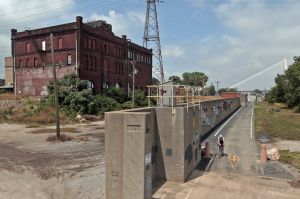What happens to the riverfront if the stadium proposal fails? 'Plan B'
http://www.stltoday.com/news/local/...cle_0ae783de-71fc-53ee-aca3-d5acc0959c7d.html
37 minutes ago • By
David Hunn
ST. LOUIS • Area leaders are working on a plan to redevelop 180 acres of riverfront real estate just north of downtown — with or without a new football stadium.
They call it “Plan B.”
The project has been in the works for months. It envisions residential towers, hotels, shops, a high-tech business incubator, plus wetlands, green space and parks stretching more than a mile, from the Gateway Arch grounds to the new river bridge. The plan even proposes floating-barge beer gardens and playgrounds.
Regional officials have been quietly peddling it to key interest groups. One night last week, some of the project’s planners met with downtown businesses and landowners. Their message was simple: With a stadium, or without, this is a unique opportunity to spur development on the riverfront.
Doug Woodruff, the second-year president of the downtown business association Downtown STL Inc., called it an effort “critical to the region, whether there’s a football team and a stadium or not.”
“It’s our one chance — our one chance as a region — to develop virtually 90 acres, on one of the world’s great rivers, next to one of the world’s great monuments,” he told the 35 or 40 members in attendance.
City and regional leaders, including Woodruff — whose organization has been hired to piece together land for the proposed stadium — insist the region must be prepared to buy the land, and soon.
Officially, however,
work on this riverfront proposal started before there was ever a Plan A.
Last summer, Great Rivers Greenway, the regional tax-supported trails organization, put out a call to study business redevelopment and trail building on the riverfront, from Laclede’s Landing past the new Stan Musial Veterans Memorial Bridge.
In November, the Greenway board picked Forum Studio from 11 bidders for the $332,000 contract. It included a blighting study — which could be used to seize land through eminent domain. Forum teamed with several consultants, among them Access Engineering, David Mason & Associates, and local market analyst Bob Lewis.
Then, in January,
Gov. Jay Nixon’s two-man task force announced plans for an open-air football stadium, smack in the middle of the 180 acres being studied. The plan, said Edward Jones Dome attorney Bob Blitz and former Anheuser-Busch President Dave Peacock, was to build a $985 million stadium, and keep the Rams from leaving St. Louis. So the riverfront plan adapted.
“If the stadium plan was there before I was there, I did not know it,” said Susan Trautman, executive director of the trails district. “The north riverfront was on my radar from the day I was hired.”
As soon as Trautman knew the stadium effort was real, she said, Great Rivers and Forum began planning on two tracks: one with a stadium and one without.
Otis Williams, executive director of the city’s development corporation, said this will require a public-private partnership. It’s a little like Cortex, the new technology district near the Central West End, he said. It took 20 years to develop.
“If the stadium is there we can build up around it,” said Williams, whose agency has sent Great Rivers $82,000 to help pay for the Forum study. They could turn stadium parking lots, for instance, into garages with first-floor retail.
“Redevelopment in this corridor will happen. It’s not a plan that will sit on the shelf,” he said. “Grade us in two to three years. That will be the real scorecard.”
If successful, it would be the first commercial riverfront redevelopment of this scale in Mayor Francis Slay’s 14-year tenure. “It’s really exciting,” said Mary Ellen Ponder, Slay’s chief of staff.
Landowners are less enthusiastic. Some like Plan B better than a stadium; some don’t. Others just want something — anything — to work out.
John Reinsch, operations manager at his family’s company, Sonn Signs, said the stadium team asked about his century-old brick warehouse on Lewis Street, a block from the floodwall.
He wasn’t thrilled. “Their initial offer was considerably lower than what we expected,” Reinsch said. The representative also wanted Reinsch to sign an “option,” paying him a percentage of the final purchase price as a promise to hold the land for later sale.
Reinsch didn’t understand: If area officials insist the land must be secured for the good of future redevelopment, then why, he asked, wouldn’t they purchase the land outright?
Some have signed. Patrick McKay, a Hilliker real estate vice president, said he represents a family with a building on North First Street. “It’s not like people were flocking down there anyway,” he said.
Seamus McGowan, co-owner of a warehouse there, wouldn’t say. But he’s skeptical of the business park idea. “Until we can bring new businesses to St. Louis, I don’t think that’s a need,” he said.
Reinsch said he declined the deal. His family is considering a counteroffer.
“I understand they’re very early in the planning stage, but I think there are a lot of questions still,” he said.
Woodruff, the Downtown STL exec, wouldn’t reveal any details of the work. Craig Heller, a developer Woodruff has contracted to compile the land, didn’t immediately return a call seeking comment.








